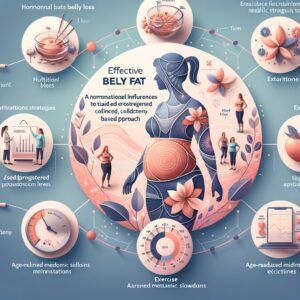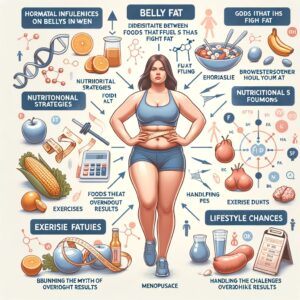In today’s fast-paced world, effective belly fat loss for women demands more than fleeting trends and quick fixes—it requires a deep understanding of hormonal influences, realistic goal setting, and a balanced, evidence-based approach.
This guide introduces readers to the intricacies of hormonal belly fat, outlines nutritional strategies that differentiate between foods that fuel versus fight fat, and debunks the myth of overnight results.
It further highlights essential exercise routines, lifestyle hacks, and targeted measures for managing challenges such as menopause. Together, these insights empower women to craft a sustainable roadmap for rapid and targeted belly fat loss that is both informed and achievable.

Seize your chance for greatness! Visit Great Life Worldwide to uncover its power. Take the free tour and start your journey today.
1. Understanding Hormonal Belly Fat: Causes and Challenges for Women
Understanding hormonal belly fat requires an examination of the intricate interplay between hormones, genetics, and lifestyle, which collectively influence fat accumulation and its persistence in the abdominal region. Women often encounter distinct challenges related to hormonal imbalances, particularly as they progress through various life stages.
Estrogen, progesterone, and cortisol are among the critical hormones involved; fluctuations or imbalances in these hormones can alter metabolism, increase appetite, and favor fat storage around the midsection.
For instance, during menopause, declining estrogen levels can lead to a redistribution of body fat, often resulting in a denser accumulation in the belly area. In addition, stress-induced cortisol secretion has a significant impact; elevated cortisol levels promote fat accumulation and may exacerbate insulin resistance.
The combination of these hormonal effects with genetic predispositions and age-related metabolic slowdowns makes targeting belly fat uniquely challenging for women. While diet and physical activity are fundamental, the hormonal environment can undermine these efforts, thus requiring tailored strategies that address both the physical and biochemical factors of weight management.
Moreover, insulin resistance, which is often hormonally influenced, further complicates fat loss by altering how the body processes nutrients and stores energy. This creates a metabolic scenario where even modest caloric excess quickly converts to stored fat. Recognizing these specific influences is essential for developing effective interventions that move beyond conventional weight loss advice.
By understanding the role of hormones, women can better appreciate that managing belly fat is not simply about calories in versus calories out, but about reclaiming hormonal balance through a comprehensive, informed approach. This approach may include dietary modifications, stress management techniques, and targeted exercise plans that address both overall health and hormonal wellness.
Through continuous assessment and personalized strategies, women can effectively navigate these hormonal challenges and achieve remarkable improvements in abdominal health and overall vitality.

Your future is calling! Answer at Great Life Worldwide and discover why it’s the perfect fit for you. Free tour available – act fast!
2. Realistic Expectations: How Much Belly Fat Can You Lose in a Month?
Setting realistic expectations for belly fat loss is crucial for sustainable progress and overall health. Several factors, including genetics, hormonal balance, age, lifestyle choices, and initial body composition, contribute to the pace at which belly fat is reduced.
Although some individuals may notice visible changes within a month, a moderate reduction of approximately 1–2 inches around the waistline is commonly observed. It’s important to note that such progress usually accompanies a decrease in overall body fat percentage and may not be distinctly isolated to the abdominal area.
In clinical studies and weight management programs, a gradual loss of 1 to 2 pounds per week is generally recommended as both safe and sustainable. This guideline is based on evidence that extreme calorie restriction or overly aggressive exercise routines can lead to muscle loss, metabolic slowdown, and an increased likelihood of rebound weight gain.
Instead, a comprehensive approach that incorporates balanced nutrition, strength training, and regular cardiovascular exercise is more effective for targeted fat reduction. Additionally, personalized factors such as individual metabolic rate, the intensity of physical activity, and adherence to nutritional guidelines have a significant impact on monthly outcomes.
Understanding that rapid changes in belly fat may be more an illusion than a reality enables women to set achievable goals, avoid discouragement, and invest in long-term health improvements. The emphasis should be on developing lifestyle habits that promote steady progress rather than seeking quick fixes.
Consulting with healthcare professionals or registered dietitians can further adjust strategies based on personal needs, ensuring that progress aligns with overall wellness objectives. In summary, while dramatic belly fat loss in one month is unlikely for most, a realistic and measured approach can lead to meaningful improvements and lay the foundation for sustained health and body composition changes. Adopting this strategy supports long-term weight management and wellness.

Elevate your life today! Visit Great Life Worldwide to uncover its power. Take the free tour and step into a brighter future now.
3. Nutritional Strategies: Foods that Fight Belly Fat vs. Foods That Fuel It
Optimizing nutrition is essential for targeted belly fat reduction in women. Foods that actively fight belly fat work by reducing inflammation, balancing hormones, and promoting efficient metabolism. High-fiber foods, such as whole grains, vegetables, fruits, and legumes, promote feelings of fullness and help stabilize blood sugar levels.
Lean proteins from poultry, fish, and plant-based sources offer muscle-sparing benefits while supporting thermogenesis and enhancing fat oxidation. Healthy fats found in avocados, olive oil, and nuts curb hunger and minimize insulin surges. Antioxidant-rich fruits and dark leafy greens protect cells from oxidative stress and contribute to overall metabolic health.
Conversely, certain foods fuel the accumulation of belly fat, undermining weight loss efforts. Highly processed carbohydrates, sugar-laden beverages, and refined sugars trigger rapid insulin responses that often lead to increased abdominal fat deposition.
Trans fats and refined oils, commonly present in fast foods and commercially baked goods, elevate inflammation levels and disrupt hormonal balance. Excessive alcohol intake further complicates metabolic regulation and encourages fat storage around the midsection.
Adopting a targeted nutritional strategy requires careful meal planning and informed food choices. Emphasizing whole, nutrient-dense ingredients while limiting processed and high-calorie items creates an optimal environment for fat reduction. A balanced approach that includes lean proteins, fiber-rich carbohydrates, and healthy fats supports sustained energy levels and enhances metabolic resilience.
Incorporating regular hydration and nutrient-dense snacks further complements this dietary regimen. Recognizing the distinct impact of food choices empowers women to implement sustainable practices that not only promote rapid belly fat loss but also bolster long-term health.
By making conscious decisions tailored to individual metabolic needs, women can effectively manage body composition and enjoy improved overall well-being. Implementing these evidence-based nutritional strategies not only lays the groundwork for a healthier lifestyle but also becomes instrumental in achieving lasting fat loss, ensuring results that are both measurable and sustainable.
4. Quick Fixes and Myths: Debunking Overnight and Fast Fat Loss Claims
In today’s wellness industry, the promise of rapid belly fat loss often attracts significant attention among women seeking immediate results. Despite the allure of overnight transformations, scientific research consistently reveals that fast fat loss claims are not only unsustainable but may also pose potential health risks.
Many purported quick-fix strategies—from extreme detox diets to high-dose supplements—rely on transient effects such as water loss or reduced inflammation rather than genuine fat reduction. These approaches typically fail to address the underlying hormonal imbalances and metabolic processes that regulate fat storage.
Health professionals advocate for a comprehensive approach that emphasizes balanced nutrition, regular physical activity, and proper recovery. Temporary interventions may yield short-term visual changes, but they rarely result in lasting improvements in overall body composition.
The idea that targeted fat can be eradicated with a magic pill or fad diet oversimplifies the complexities of human physiology. Successful fat loss demands gradual behavioral changes and consistent lifestyle modifications that support long-term health.
Moreover, the appeal of rapid fixes can lead to disillusionment and frustration when immediate results do not materialize. Women are advised to remain skeptical of sensational claims and to prioritize methods grounded in scientific evidence.
By critically evaluating the promises of quick fixes and avoiding dangerous shortcuts, individuals can develop a realistic understanding of fat loss. Focusing on sustainable habits rather than temporary solutions ultimately promotes steady progress and reduces the risk of rebound weight gain.
By adopting a methodical, evidence-based approach, women can achieve meaningful and lasting improvements in their health and well-being, thereby debunking the myth of overnight fat loss.
By adopting realistic goals and understanding the science behind fat metabolism, women can steer clear of misleading marketing tactics. Informed choices and persistent effort remain the cornerstones for achieving lasting and effective fat loss without resorting to unproven quick fixes.

Ready to soar? Take flight with Great Life Worldwide! Learn why it’s your launchpad to success. Free tour available—act now!
5. Exercise Essentials: Targeting Belly Fat and Effective Workouts Over 50
For women over 50, tailoring exercise routines to target belly fat requires a thoughtful and multifaceted approach. While it’s not possible to burn fat from specific areas in isolation, incorporating a blend of cardiovascular training, strength-building exercises, and core stabilization can help reduce overall body fat, including the midsection.
A combination of moderate-intensity cardio, such as brisk walking, cycling, or swimming, establishes a solid foundation for increasing metabolism and enhancing overall fitness. Regular cardiovascular activity improves heart health while gradually mobilizing fat deposits.
Strength training is particularly vital for mature women. Engaging in resistance exercises two to three times per week not only helps preserve muscle mass but also fosters an elevated metabolic rate. Utilizing lighter weights, resistance bands, or body-weight movements ensures that exercises are both practical and safe.
Core-focused workouts, such as planks, seated abdominal exercises, and modified crunches, further strengthen the midsection and enhance posture. Slowly increasing the intensity and duration of these exercises allows the body to adapt while minimizing the risk of injury.
Additionally, incorporating balance and flexibility exercises, such as yoga or Pilates, can enhance stability and reduce the risk of falls. This varied exercise regimen addresses the challenges associated with aging and hormonal changes impacting fat distribution.
A consistent, personalized exercise plan tailored to individual fitness levels and any pre-existing conditions is essential. By combining cardio, strength, core, and flexibility training, women over 50 can effectively target overall fat loss while promoting long-term health and resilience.
It’s advisable to work with a fitness professional to adapt exercises to one’s personal health needs and limitations. Progressive modifications and periodic reassessments ensure that the workout remains challenging yet safe, ultimately optimizing fat reduction and overall vitality for women navigating the unique complexities of aging. This dedicated, structured approach consistently fosters sustainable progress.

Unleash your inner champion! Discover how Great Life Worldwide can help you and understand why it’s the winning team for you. Take the free tour today!
6. Lifestyle Hacks: Boosting Metabolism with Juice, Vitamins, and Sleep
In the pursuit of a healthier body composition, adopting targeted lifestyle adjustments can be a key factor. Integrating nutrient-dense juices into your daily routine supports hydration and supplies a concentrated dose of antioxidants and phytonutrients. Fresh vegetable and fruit blends, augmented with ginger or lemon, help stimulate digestion and may enhance metabolic function.
Consuming these juices in the morning can be an efficient method for kickstarting the metabolism and supplying essential vitamins that support overall well-being. Furthermore, ensuring your body receives the right vitamins is crucial for maintaining an efficient metabolic rate.
Vitamins such as D and the B-complex, as well as antioxidants like vitamin C, have demonstrated their importance in energy utilization and cellular repair. A well-balanced supplementation or dietary intake that supports the metabolic pathways can lead to more efficient energy expenditure, reducing the risk of unwanted fat storage. Professional guidance from a nutritionist can help tailor this vitamin strategy according to individual needs.
Equally significant is the role of sleep in metabolic regulation. High-quality rest is essential for maintaining hormonal balance, which ultimately regulates metabolic rate and fat distribution. Inadequate or disrupted sleep patterns can increase stress hormones, such as cortisol, which may contribute to the accumulation of abdominal fat.
Prioritizing a consistent sleep schedule, optimizing the sleep environment, and integrating relaxation techniques before bedtime are all effective strategies to enhance sleep quality. The synergy of restorative sleep, appropriate nutrient intake, and revitalizing juices creates an environment conducive to metabolic health.
By incorporating these lifestyle hacks into a daily routine, women can strategically target metabolic inefficiencies associated with abdominal fat accumulation. Thoughtfully selected juices, vitamins, and a focus on quality sleep offer a comprehensive approach that supports energy regulation and overall health, ultimately fostering a more sustainable pathway for achieving a leaner midsection.
7. The Bigger Picture: Managing Menopause, Hormonal Imbalances, and Persistent Belly Fat
In many cases, persistent belly fat in women is intricately linked to hormonal fluctuations associated with menopause and underlying endocrine imbalances. During this transitional phase, declining estrogen levels often lead to a redistribution of body fat toward the abdominal area. At the same time, shifts in other hormones, such as cortisol, insulin, and thyroid, also play a significant role. Recognizing these interrelated factors is crucial for developing effective strategies to manage persistent belly fat.
A comprehensive approach that integrates balanced nutrition, specialized exercise regimens, and clinical support can help mitigate these hormonal challenges. Adopting a nutrient-rich diet that emphasizes anti-inflammatory foods, lean proteins, and complex carbohydrates can help stabilize blood sugar levels and support metabolic health.
Additionally, regular physical activity tailored to individual abilities—notably strength training, aerobic routines, and flexibility exercises—facilitates muscle preservation and improves insulin sensitivity. This coordinated strategy is particularly valuable for women facing the compounded effects of menopause and aging.
Furthermore, partnering with healthcare professionals for regular evaluations can be indispensable. Personalized medical interventions, such as hormonal assessments or hormone replacement therapy, may provide necessary insights and support to create sustainable solutions.
This evidence-based approach ensures that treatment plans address both the superficial symptom of fat accumulation and the underlying hormonal imbalances contributing to it. By considering the bigger picture, women can adopt proactive measures that not only target belly fat reduction but also improve overall health and well-being, a critical period of change.
By embracing an integrated regimen that acknowledges both lifestyle and hormonal influences, individuals can more effectively navigate the complexities of body composition changes. Ongoing research continues to shed light on effective interventions, ensuring that clinical practices evolve in tandem with the advancement of scientific understanding. Such informed strategies empower women to manage their health proactively at this stage.

Your future is knocking! Explore opportunities at Great Life Worldwide and discover how it can open doors for you. Free tour available – seize the moment!
Conclusion:
This comprehensive guide emphasizes that rapid and targeted belly fat loss is achievable through an integrated strategy that combines balanced nutrition, tailored exercise, and informed lifestyle adjustments.
By demystifying hormonal complexities and debunking quick-fix myths, it sets realistic expectations and inspires women to embrace sustainable habits that enhance overall health. Ultimately, this resource serves as a vital toolkit for those ready to reclaim vitality and achieve a lasting transformation in their journey toward better abdominal health.

